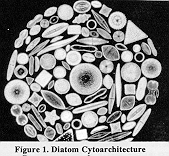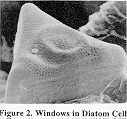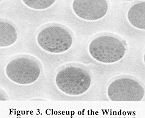A sunny pleasure dome with caves of ice!
(Samuel Taylor Coleridge on the Pleasure Palace of Kubla Khan)
From the evolutionary view of the biosphere, the Kingdom Protista—which comprises the unicellular eukaryotic organisms (protozoa, algae, and slime molds)—is primitive to "higher" life forms—multicellular animals and plants—yet among its members is manifested the greatest complexity of cell structure known. Exemplary of this point are the diatomaceous algae (Bacilliariophycea), whose cytoarchitecture exhibits perhaps the most exquisite geometry seen in the natural world1 (figure 1).
Diatoms are truly microorganisms—too small to be seen with the naked eye. With an average diameter of 25 microns (10-6 meters), four individual diatoms could be laid across the breath of a human hair.
 In terms of population numbers, however, diatoms are a huge component of the earth's biota, making up about 90% of all living organisms in the ocean (there are also species of diatoms inhabiting fresh water). These and other photosynthetic phytoplankton constitute the trophic base of the ocean's food chains, responsible for the production of some 130,000 million tons of organic carbon per year. As such, diatoms play a vital role in the earth's ecology. And to those students of nature who are receptive to it, they give us a lesson in the philosophy of design and its significance.
In terms of population numbers, however, diatoms are a huge component of the earth's biota, making up about 90% of all living organisms in the ocean (there are also species of diatoms inhabiting fresh water). These and other photosynthetic phytoplankton constitute the trophic base of the ocean's food chains, responsible for the production of some 130,000 million tons of organic carbon per year. As such, diatoms play a vital role in the earth's ecology. And to those students of nature who are receptive to it, they give us a lesson in the philosophy of design and its significance.
Diatoms have been a marvel to microscopists since Ernst Haeckel's mid-19th century descriptions of the first of what now amount to some 10,000 species living today, and in the fossil record. The fascination is with the geometrically intricate structure of the cell wall. As for other kinds of algae and the cells of plants per se, the cell wall of diatoms contains cellulose. The special orientation of the cellulose microfibrils is guided by an array of microtubules in the cortical cytoplasm, which in turn becomes a determinant of cell shape. In concert with the deposition of silica (as silicic acid, Si[OH]4, taken up from the environmental milieu) a topography of elaborately sculpted patterns of grooves, flanges, and spicules is established; as these are inlaid with hydrous silicon oxide, the diatoms' opaline shells, or tests, are produced. This patterned framework is repeatedly perforated with minute pores, or fenestrae (figures 2,3), through which pseudopodial cytoplasmic processes pass in the course of nutrient acquisition and locomotion. The result is one of astonishing beauty—perfect symmetry, top to bottom, left to right, and front to back, in a plethora of geometric shapes—circles, squares, triangles, ovals, stars, and rectangles (figure 1). (Note, silica is the stuff of which opals are made [more mundane substances composed of silica are sand, quartz, chert, and glass]. The biogenic opaline structure of diatome tests indicates that millions of years would not necessarily be required for the formation of these gemstones as it is commonly purported.) Like other algae, diatoms contain the green pigment chlorophyll, but the presence of additional pigments, notably the yellowish xanthophylls, give these organisms a rich golden brown hue. The artistry is further embellished by the way in which diatoms reproduce, which is usually by cell division, but with a twist. Diatom cell walls consist of almost identical halves which fit together like a box fits into its lid. With division, each half separates and produces a slightly smaller shell that fits within the old one, a scheme reminiscent of Russian Matrishka dolls. Subsequent divisions result in a succession of ever smaller daughter cells, until a minimum size limit is reached. A process of sexual reproduction, by means of spores (gametes), is then activated, giving rise to diatoms of the original size.


Altogether, diatoms are aptly referred to as jewels of the sea. Fabergé's finest creations pale in comparison to those of the Creator!
Diatom shell structure is species specific; i.e., all organisms of the same species have essentially the same shell shape and infrastructure (though there are minor individual variations, so that no two diatoms are exactly alike), but the pattern is different for each species. Thus, as a character of taxonomic significance, it may be inferred that diatom shell structure is determined, ultimately, by genetic information. Meanwhile, the geometric diversity displayed appears to be non-adaptational—i.e., undiminished by natural selection. This is beauty for its own sake, unfettered by evolutionary pragmatism!
Nonetheless, for all their aesthetic qualities, diatoms are also a practical environmental resource. As photosynthetic autotrophs, they manufacture their own nutrition, which in turn represents a substantial percentage of the earth's annual production of organic carbon. In the process they are significant consumers of carbon dioxide and are responsible for the production of much of the earth's atmospheric oxygen. Their syntheses include that of a very high quality oil (comparable to peanut, linseed, and cotton oils) occupying up to 10% of the cell's volume (the diatoms use this oil as a metabolic energy reserve). While chemically different from that found in oil fields per se, it is not unlikely that fossil beds of diatoms containing billions of cubic feet of these microbes have contributed to the earth's hydrocarbon deposits. As primary producers, diatoms constitute the major food item for many fish (supplying among other nutrients most of the vitamin D found in fish oils) and other aquatic animals, including the largest of all—whales. Diatomaceous earth (deposits of their sedimented siliceous tests—diatomite rock from fossil beds, furlers' Barth from more recent sediments) has industrial application as a fine abrasive and is used in filtering and insulating materials. When absorbed by diatomite (which Alfred Nobel knew as Kieselguhr), nitroglycerine becomes stable and thus we have dynamite. Diatoms have proven extremely useful as guide fossils to the geologists' location of petroleum deposits for the oil and gas industry. Ecologically, they significantly impact the inorganic chemical concentrations of the aquatic environment, especially of silica, nitrates, and phosphates, playing a major role in their cycling between the animate and inanimate components of the biosphere. Under certain circumstances (e.g., fertilizer runoff, resultant phosphate pollution and microbial blooms), this can have the adjunctive function of purifying fouled water supplies.
Besides diatoms, planktonic organisms for which silica is a structural component, are the silicoflagellates and some of the radiolarians. A group of protists resembling diatoms in their form are the polythalamian foraminifera. They differ from diatoms in having tests of calcium carbonate. The obvious function of these shells, siliceous or calcareous, is that of an exoskeletal support system, one perhaps adjunctive to their buoyancy, though most protists get along very well without them (see, e.g., the shell-less radiolarians).
Geometric form is also seen in purely physical (abiotic) systems, as in the case of crystals. Indeed, most solid matter has orderly atomic arrangement and is of crystalline structure when a solid is formed gradually from a fluid (a notable exception is glass). Outward form is bounded by smooth, planar, symmetrically arranged surfaces (facets) which develop in response to directional forces within the growing crystal itself. Each chemical element (or compounds thereof, e.g., salts and oxides) tends to crystallize in a definite and characteristic form. The apparently infinite variability of form exhibited by snowflakes—every snow crystal is unique in its precise configuration—is due to the unlimited variation in the specific micro-weather conditions under which they are assembled (combinatorily, the number and distribution of ice nucleation centers in a developing snowflake are infinitely variable, thus the chance of a repeat becomes mathematically impossible).
Engineers, who by and large are less prone to flights of evolutionary fancy than biological theorists, note that one characteristic of functional design is elegance.1 Where natural systems are the example, reference is to an essential elegance, one more fundamental than mere appearance; beautiful outward form is a reflection of economical design. To a consideration of the design principle, it is significant that the geometry exhibited by diatoms goes above and beyond the aforementioned intrinsic organizational properties of physical matter—e.g., crystalline geometry—in its informational determinants, which, as embodied in the organisms' genetics (vice supra), are extrinsic to the components of the shell structures themselves. The intricate micromorphology of these organisms is neither predictable nor constrained by the physical qualities of its constituent elements, noting that biogenic silica as opal has no inherent crystalline structure (cf. Iithogenic silica), but in the solid state is amorphous. Cf. the case of snowflake formation where I = 0 (see below), information is a quality which when imposed on a dynamic system reduces an indefinite number of possible outcomes to a singularity—as we have it in the species specific form of diatom shells.
Thus, if I0 = 0 (when no information is available, I1 ‡ 0 (when information is gained), P0 is the probability for possible outcomes, P1 = 1 (when, as a result of specifying information, a single outcome is selected), then:
In the totality of our human experience, there is but one source of meaningful information, and that is intelligence. Proponents of chaos theory might have it otherwise. To a non-theistic evolutionist, who would perforce gainsay the impingement of creative intelligence on the natural world, what is perceived as design in biological systems is attributable to the organizational properties of matter itself, or a stochastic trial and error process in the evolution of the genetic base. Yet the same evolutionist has no problem with identifying artifacts such as arrowheads for what they are and accordingly attributing to them an intelligent source, with the conviction that such geometric shapes, albeit much less complex than those manifested by diatoms, do not form by mindless chance. Why are diatoms, so exquisitely complex, so singularly beautiful to study?
The answer is in Romans 1:20: "For the invisible things of Him from the creation of the world are clearly seen, being understood by the things that are made, even His eternal power and Godhead; so that they are without excuse."
In all their aesthetic intricacy, could diatoms be simply the calling card of the Master Designer? With that in mind, we dedicate this paper to the memory of Dr. Richard Bliss, who was so quick to comprehend and appreciate design in nature— its source—and who was so effective in educating his students—K through faculty colleagues—to that principle.
1 M. Armitage, Creation Research Society Quarterly, vol. 31 (1994): 167-160. This paper should be consulted for a bibliography of the points addressed in the present article. Also see M. French, Invention and Evolution: Design in Nature and Engineering (Cambridge University Press), C. Froede, CRSQ 32:11, and P. Treguer et al., Science 268:375-379.
* Mark Armitage is the president of MicroSpecialists and a student in biology at the ICR Graduate School.
** Dr. Lumsden is Chairman of the Biology Department at ICR and Professor of Biology at The Master's College.



















